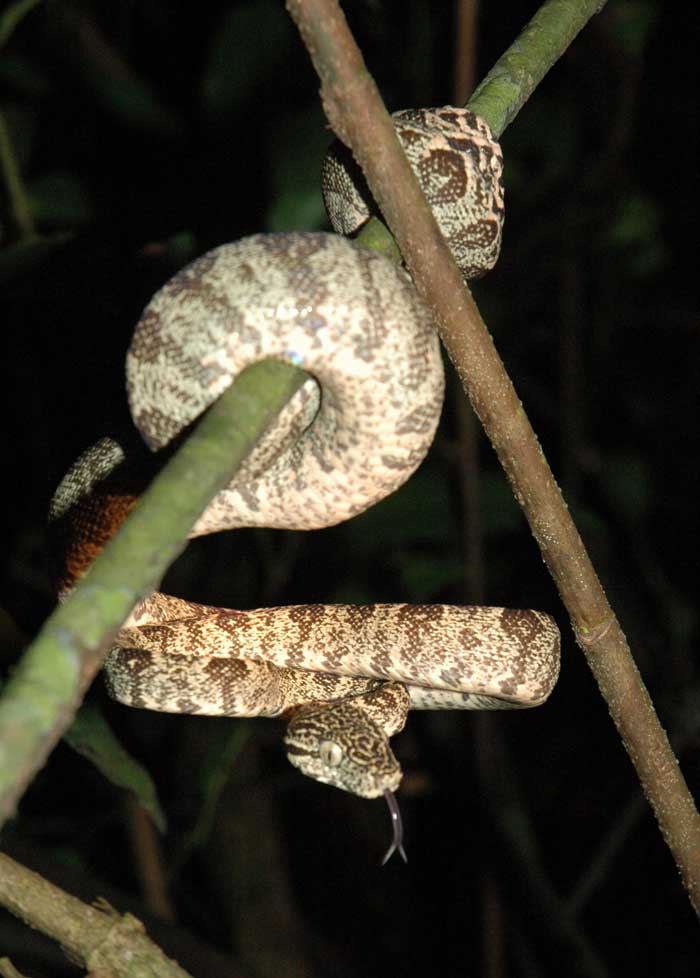
Corallus hortulana
Superregnum: Eukaryota
Regnum: Animalia
Subregnum: Eumetazoa
Cladus: Bilateria
Cladus: Nephrozoa
Superphylum: Deuterostomia
Phylum: Chordata
Subphylum: Vertebrata
Infraphylum: Gnathostomata
Superclassis: Tetrapoda
Cladus: Reptiliomorpha
Cladus: Amniota
Classis: Reptilia
Cladus: Eureptilia
Cladus: Romeriida
Subclassis: Diapsida
Cladus: Sauria
Infraclassis: Lepidosauromorpha
Superordo: Lepidosauria
Ordo: Squamata
Subordo: Serpentes
Superfamilia: Booidea
Familia: Boidae
Subfamilia: Boinae
Genus: Corallus
Species: Corallus hortulana
Name
Corallus hortulana (Linnaeus, 1758)
Holotype: SMNH Lin. 7.
Type locality: “America”.
Combinations
Boa hortulana Linnaeus, 1758: 215 [original combination]
Synonyms
Boa enydris Linnaeus 1758: 215
Vipera bitis Laurenti 1768: 102
Vipera madarensis Laurenti 1768: 102
Coluber madarensis - Gmelin 1788: 1092
Coluber bitis - Gmelin 1788: 1092
Boa Ambleocephala Donndorff 1798: 1798: 149
Boa merremi Schneider 1801: 259
Boa obtusiceps Bechstein 1802: 46
Boa elegans Daudin 1803: 123
Corallus obtusirostris Daudin 1803: 259
Xiphosoma ornatum Wagler 1824: 40
Xiphosoma dorsuale Wagler 1824: 43
Xiphosoma hortulana - Fitzinger 1826: 883
[Xiphosoma] merremii - Wagler 1830: 167
Boa modesta Reuss 1834: 129
Boa hortulana - Schlegel 1837: 392
Corallus maculatus Gray 1842: 42
Corallus hortulanus - Gray 1842: 42
Corallus Cooki Gray 1842: 42
Xiphosoma hortulanum - Duméril & Bibron 1844: 545
Corallus hortulanus melanea Gray 1849: 98
Xiphosoma ruschenbergerii Cope 1875: 129
Xiphosoma hortulanum — Garman 1887: 279
Corallus cookii - Boulenger 1893: 99
Corallus hortulanus - Boulenger 1893: 101
Boa ruschenbergii - Stejneger 1901: 184 (in errore)
Boa grenadensis Barbour 1914: 327
Boa salmonidia Briceño Rossi 1934: 1141
Boa enydris enydris - Stull 1935: 388
References
Primary references
Linnaeus, C. 1758. Systema Naturae per regna tria naturae, secundum classes, ordines, genera, species, cum characteribus, differentiis, synonymis, locis. Editio Decima, Reformata. Tomus I. Holmiæ (Stockholm): impensis direct. Laurentii Salvii. 824 pp. DOI: 10.5962/bhl.title.542 BHL Reference page.
Additional references
Schwartz, A. & Henderson, R.W. 1991. Amphibians and Reptiles of the West Indies. University of Florida Press, Gainesville. 720 pp.
McDiarmid, R.W., Campbell, J.A. & Touré, T.A. 1999. Snake species of the world. Vol. 1. Herpetologists’ League. 511 pp.
Frétey, T. 2019. Capitalised epithets in the works of Linnaeus (1758‒1767): findings and consequences in herpetology. Bionomina 16(1): 22–45. DOI: 10.11646/bionomina.16.1.2 Paywall Reference page.
Links
Uetz, P. & Hallermann, J. 2022. Corallus hortulana. The Reptile Database. Accessed on 24 June 2021.
Calderón, M., Ortega, A., Nogueira, C., Gagliardi, G., Cisneros-Heredia, D.F., Hoogmoed, M., Schargel, W. & Rivas, G. 2016. IUCN: Corallus hortulanus (Least Concern). The IUCN Red List of Threatened Species 2016: e.T203210A2762194. DOI: 10.2305/IUCN.UK.2016-3.RLTS.T203210A2762194.en
Vernacular names
čeština: Psohlavec orinocký
Deutsch: Hundskopfboa
English: Garden Tree Boa
español: Boa arborícola amazónica
Nederlands: Tuinboa
norsk: Hagetreboa
polski: Boa leśny
português do Brasil: Boitinga
русский: Садовый удав
українська: Удав садовий
Corallus hortulana is a non-venomous boa species found in South America. No subspecies are currently recognized.[3]
Description
Adults grow to an average of 5 and 6.5 feet (1.5–2 m) in length.[5] This species exhibits an immense variety of colors and patterns. The basic color can be anywhere from black, brown, or gray, to any shade of red, orange, yellow, or many colors in between. Some are totally patternless, while others may be speckled, banded, or saddled with rhomboid or chevron shapes. Some reds will have yellow patterns, some yellows red or orange patterns. Generally, there are two color 'phases' that are genetically inherited, but are not ontogenic as with the emerald tree boa,C. caninus and the green tree python, Morelia viridis. The 'garden phase' refers to boas with drab coloration, mostly brown or olive, with varied patterning, while the 'colored phase' refers to animals with combinations of red, orange, and yellow coloring.
adult in Peru
juvenile in Peru
Geographic range
Found in South America in southern Colombia east of the Andes, southern Venezuela, Guyana, Suriname, French Guiana, Amazonian Brazil, Costa Rica, Ecuador, Peru, and Bolivia. The type locality given is "America."[2]
Typically found below 300 m elevation.
References
NatureServe (2013). "Garden Tree Boa Corallus hortulanus". IUCN Red List of Threatened Species. 2013. Retrieved 15 December 2014.
McDiarmid RW, Campbell JA, Touré T. 1999. Snake Species of the World: A Taxonomic and Geographic Reference, vol. 1. Herpetologists' League. 511 pp. ISBN 1-893777-00-6 (series). ISBN 1-893777-01-4 (volume).
"Corallus hortulanus". Integrated Taxonomic Information System. Retrieved 14 July 2008.
Mehrtens JM. 1987. Living Snakes of the World in Color. New York: Sterling Publishers. 480 pp. ISBN 0-8069-6460-X.
Burnie D, Wilson DE. 2001. Animal. Dorling Kindersley. 624 pp. ISBN 0-7894-7764-5.
Further reading
Mattison C. 1999. Snake. DK Publishing. ISBN 0-7894-4660-X.
Retrieved from "http://en.wikipedia.org/"
All text is available under the terms of the GNU Free Documentation License

